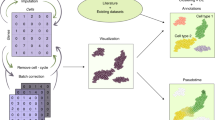Abstract
After analysing gene-expression profiles of colon cancers on a cDNA microarray containing cDNAs corresponding to 23 040 human genes, we focused on a gene annotated as C10orf3 (chromosome 10 open reading frame 3), whose expression was elevated in colorectal cancers (CRC) as well as in tumors arising in the stomach, lung, pancreas, and breast. The gene encodes a putative 464-amino-acid protein containing a domain known as AAA (ATPases associated with a variety of cellular activities). Western blot analysis using an antibody to the gene product confirmed that the protein was overexpressed in nine of the 15 clinical cancer tissues examined, compared to corresponding noncancerous epithelial cells. A subsequent proteomics analysis revealed that C10orf3 product associated with the product of tumor susceptibility gene 101 (TSG101), and that C10orf3 downregulated TSG101 in a post-transcriptional manner. Expression of short interfering RNA in cells derived from CRC caused significant decreases in C10orf3 expression and inhibited growth of the transfected cells, which was associated with increased apoptotic cells. These data suggest that elevated C10orf3 expression might play an essential role in the growth of cancer cells, and that suppression of C10orf3-mediated signal transduction may be a novel therapeutic strategy to a wide range of human tumors.
This is a preview of subscription content, access via your institution
Access options
Subscribe to this journal
Receive 50 print issues and online access
$259.00 per year
only $5.18 per issue
Buy this article
- Purchase on Springer Link
- Instant access to full article PDF
Prices may be subject to local taxes which are calculated during checkout




Similar content being viewed by others
Accession codes
References
Bishop N, Woodman P . (2001). J. Biol Chem 276: 11735–11742.
Douillard JY, Cunningham D, Roth AD, Navarro M, James RD, Karasek P et al. (2000). Lancet 355: 1041–1047.
Garrus JE, von Schwedler UK, Pornillos OW, Morham SG, Zavitz KH, Wang HE et al. (2001). Cell 107: 55–65.
Gridelli C, Rossi A, Maione P . (2003). Oncogene 22: 6629–6638.
Hasegawa S, Furukawa Y, Li M, Satoh S, Kato T, Watanabe T et al. (2002). Cancer Res 62: 7012–7017.
Jessberger R . (2002). Nat Rev Mol Cell Biol 3: 767–778.
Kikuchi T, Daigo Y, Katagiri T, Tsunoda T, Okada K, Kakiuchi S et al. (2003). Oncogene 22: 2192–2205.
Lee MP, Feinberg AP . (1997). Cancer Res 57: 3131–3134.
Li L, Cohen SN . (1996). Cell 85: 319–329.
Li L, Liao J, Ruland J, Mak TW, Cohen SN . (2001). Proc Natl Acad Sci USA 98: 1619–1624.
Lin YM, Furukawa Y, Tsunoda T, Yue CT, Yang KC, Nakamura Y . (2002). Oncogene 21: 4120–4128.
Molina MA, Codony-Servat J, Albanell J, Rojo F, Arribas J, Baselga J . (2001). Cancer Res 61: 4744–4749.
Nakamura T, Furukawa Y, Nakagawa H, Tsunoda T, Ohigashi H, Murata K et al. (2004). Oncogene 23: 2385–2400.
Neuwald AF, Aravind L, Spouge JL, Koonin EV . (1999). Genome Res 9: 27–43.
Nishidate T, Katagiri T, Lin ML, Mano Y, Miki Y, Kasumi F et al. (2004). Int J Oncol 25: 797–819.
Obama K, Ura K, Katagiri T, Tsunoda T, Nomura A, Satoh S et al. (2005). Hepatology 41: 1339–1348.
O'Dwyer ME, Druker BJ . (2000). Curr Opin Oncol 12: 594–597.
Okabe H, Satoh S, Furukawa Y, Kato T, Hasegawa S, Nakajima Y et al. (2003). Cancer Res 63: 3043–3048.
Okabe H, Satoh S, Kato T, Kitahara O, Yanagawa R, Yamaoka Y et al. (2001). Cancer Res 61: 2129–2137.
Saltz LB, Cox JV, Blanke C, Rosen LS, Fehrenbacher L, Moore MJ et al. (2000). N Engl J Med 343: 905–914.
Shimokawa T, Furukawa Y, Sakai M, Li M, Miwa N, Lin YM et al. (2003). Cancer Res 63: 6116–6120.
Sun Z, Pan J, Bubley G, Balk SP . (1997). Oncogene 15: 3121–3125.
Wagner KU, Krempler A, Qi Y, Park K, Henry MD, Triplett AA et al. (2003). Mol Cell Biol 23: 150–162.
Walt G . (2004). BMJ 328: 6.
Xie W, Li L, Cohen SN . (1998). Proc Natl Acad Sci USA 95: 1595–1600.
Zhong Q, Chen Y, Jones D, Lee WH . (1998). Cancer Res 58: 2699–2702.
Zhu G, Gilchrist R, Borley N, Chng HW, Morgan M, Marshall JF et al. (2004). Int J Cancer 109: 541–547.
Acknowledgements
We appreciate the technical assistance of Yoshika Sakamoto, Noriko Ikawa, and Tae Makino and the contributions of Dr Toyomasa Katagiri for the preparation of anti-C10orf3 antibody, and are grateful to Ryuji Hamamoto and Kazutaka Obama for helpful discussions. This work was supported in part by the Research for the Future Program Grant #00L01402 from the Japan Society for the Promotion of Science.
Author information
Authors and Affiliations
Corresponding author
Rights and permissions
About this article
Cite this article
Sakai, M., Shimokawa, T., Kobayashi, T. et al. Elevated expression of C10orf3 (chromosome 10 open reading frame 3) is involved in the growth of human colon tumor. Oncogene 25, 480–486 (2006). https://doi.org/10.1038/sj.onc.1209051
Received:
Revised:
Accepted:
Published:
Issue Date:
DOI: https://doi.org/10.1038/sj.onc.1209051
Keywords
This article is cited by
-
Evaluation of CEP55, SERPINE1 and SMPD3 genes and proteins as diagnostic and prognostic biomarkers in gastric carcinoma in Egyptian patients
Beni-Suef University Journal of Basic and Applied Sciences (2022)
-
CEP55 3’-UTR promotes epithelial–mesenchymal transition and enhances tumorigenicity of bladder cancer cells by acting as a ceRNA regulating miR-497-5p
Cellular Oncology (2022)
-
Genes CEP55, FOXD3, FOXF2, GNAO1, GRIA4, and KCNA5 as potential diagnostic biomarkers in colorectal cancer
BMC Medical Genomics (2019)
-
SPAG5 interacts with CEP55 and exerts oncogenic activities via PI3K/AKT pathway in hepatocellular carcinoma
Molecular Cancer (2018)
-
Centrosomal protein 55 activates NF-κB signalling and promotes pancreatic cancer cells aggressiveness
Scientific Reports (2017)



